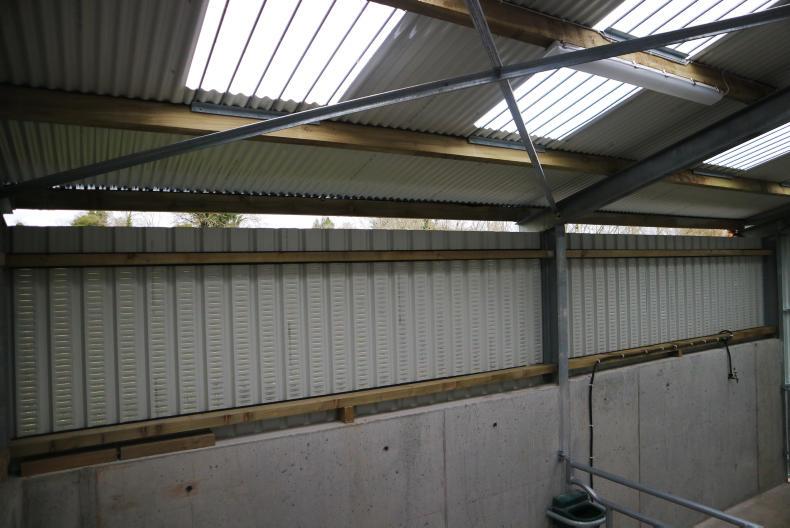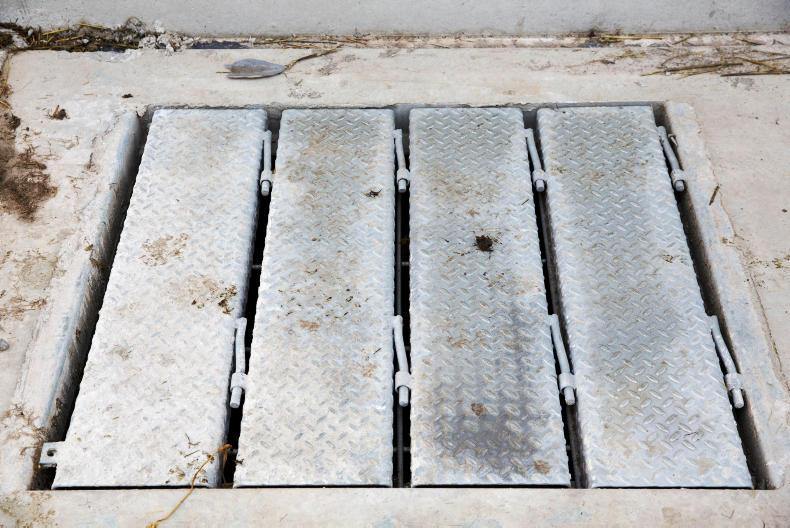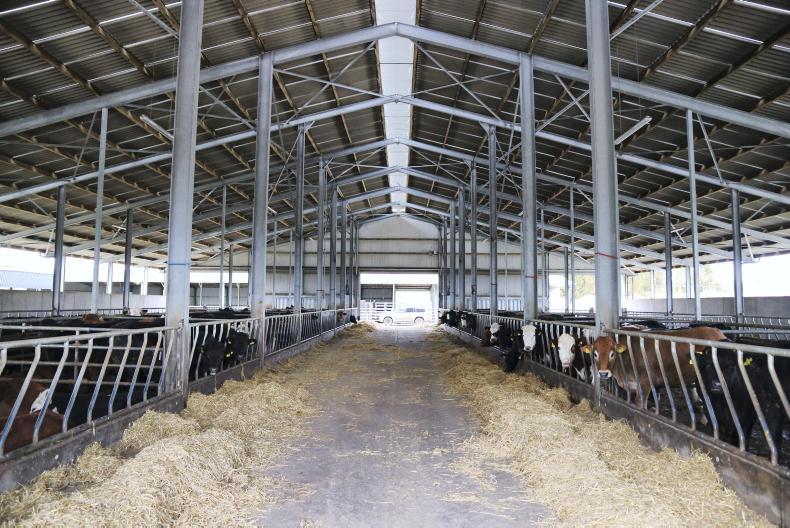Last week, we looked at the importance of building to Department of Agriculture specifications. One issue that was continuously raised was the incorrect designs that are often submitted to the Department when farmers are looking for grant aid on a building.
This week, we examine some of the key specifications that farmers must be aware of when deciding on the design they want for their shed.
The Department’s specifications can be a daunting set of documents to read through, but it is worth putting in the time to ensure that your shed is properly designed.
All buildings which are being built through TAMS are required to be built to Department specifications, but even those built outside of the grant should be built to the same standards to ensure a long-lasting building that only requires minimal maintenance.
General design
The vast majority of slatted units will be a simple steel frame. The Department specifications cover these simple steel frame buildings with a maximum eave height of 5m and a roof slope of 12° to 15°.
If the eave height is higher and/or the roof slope outside the specified range, then a full design will need to be undertaken by a chartered engineer, which can add considerable costs to a project.
The minimum permitted eave height of a shed is 3m, or 2.75m for dairies and milking premises.
Ventilation is one of the key areas where the design of buildings is falling down. Proper ventilation must be provided to all livestock buildings as a strict condition of grant aid in order to protect animal health and the working life of the building.
Outlet ventilation must be provided along the full length of the apex of the roof and varies depending on the width of the shed, as outlined in Table 1.
A central ridge outlet, while recommended, is not required where spaced sheeting with a gap of 20mm is installed over the entire roof of the shed. Where a ridge cap is fitted, it must be a certain distance clear of the roof (Table 1).
For a mono-pitched or one-sided shed fitted with a canopy on the open side, the requirement is to have a 275mm-wide outlet along the length of the roof, positioned near the highest point.
Buildings are also required to have inlet ventilation along the full length of each side of the shed or the lower side of a mono-pitched shed.
Vented sheeting is recommended for inlet ventilation, positioned directly below the eaves. It must have a minimum depth of 1.5m. Where the shed is more than 15m, then an unobstructed opening, in combination with vented sheeting, must be used directly under the eaves, as outlined in Table 2.
In wide-span houses, it is strongly recommended that ventilated sheets should be used for gable cladding.
Where you are extending an existing shed, then the ventilation spacings must be sized for the combined structure and not just the new part.
This may mean that alterations will have to be made to the existing building to improve inlet ventilation, such as removing cladding.
An important aspect that farmers must be aware of when they are at the initial stages of their design is that cattle and sheep must not be housed in the same building due to the possible transfer of common diseases.
An exception to this rule applies where a wall the full height of the building exists, separating both sheep and cattle in a way that they have separate inlet and outlet ventilation, as well as separate access points.

In a shed more than 15m wide then an unobstructed opening, in combination with vented sheeting must be used directly under the eaves.In a shed more than 15m wide then an unobstructed opening, in combination with vented sheeting must be used directly under the eaves.
Slatted shed
For new buildings, the minimum width of a central feed passage must be 4m. However, it is strongly recommended that it is at least 5.5m wide. It is also recommended that this feed passage is at least 50mm above the level of the animal.
The floor area per cow in a slatted suckler shed depends on the size of the cow and the calving date. Autumn-, winter- and early spring-calving cows require more space than cows calving post-housing.
A floor area of 2.5m2 to 3.5m2 is required, depending on the circumstances. For feeding purposes, the minimum feeding space must be 400mm, but is recommended to be 600mm per cow.
Creep area
There have been fairly substantial changes made to the designs of the creep area in a shed. The main change means that all creep pens must be accessible without passing through another animal pen.
This must be applied to all buildings where planning permission or declaration of exemption is sought after 6 September 2017.
There are two ways of providing this – either by providing an access passageway to the rear of the pen or via separate doors or gates to pens from the outside wall of the shed.
For creep areas more than 20m (or five bays) long, sliding doors must be provided at either end, while for a shed less than 20m or four bays in length, a sliding door is only required on one side. This ensures cleaning out the creep area can be done with ease.
When installing a cattle crush in a shed, it must be a minimum of 4m and preferably at least 6m between the front of the crush and any facing wall, solid barrier or door.
Cubicle sheds
There are several design aspects which must be included for cubicle houses. Firstly, cows must have at least two routes to the feed face.
No dead-end passageways should be in place in the shed. Crossover points between rows must be a minimum of 2.3m (two cubicles) wide or 3.5m (three cubicles) wide if a drinker is positioned at the point.
In all cubicle sheds there must be a minimum of 3.5m standing area at the feed face, with at least two drinkers, and preferably four, per 50 cubicle spaces.
When it comes to the scraped passageways behind the cubicles, they must be at least 1.8m wide and it is recommended that they are 2.7m wide.

Agitation points must not be installed inside any houses. Agitation points must not be installed inside any houses.
Agitation points
There are several key areas in relation to agitation points that farmers must be aware of when designing their building. The most important thing is that agitation points must not be installed inside any houses.
Additionally, where an existing building is being extended or converted and there is an internal agitation point, then this agitation point must be removed.
All necessary work must then be done to allow for full external agitation of the existing building.
Additionally, if a farmer is looking to get grant aid on a bulk tank, for example, that will be situated in a shed that has an internal agitation point, they will be ineligible to do so unless the internal agitation point is removed. However, grant aid can be received to do this.
Read more
Could changing weather patterns alter the way we use fertiliser?
Last week, we looked at the importance of building to Department of Agriculture specifications. One issue that was continuously raised was the incorrect designs that are often submitted to the Department when farmers are looking for grant aid on a building.
This week, we examine some of the key specifications that farmers must be aware of when deciding on the design they want for their shed.
The Department’s specifications can be a daunting set of documents to read through, but it is worth putting in the time to ensure that your shed is properly designed.
All buildings which are being built through TAMS are required to be built to Department specifications, but even those built outside of the grant should be built to the same standards to ensure a long-lasting building that only requires minimal maintenance.
General design
The vast majority of slatted units will be a simple steel frame. The Department specifications cover these simple steel frame buildings with a maximum eave height of 5m and a roof slope of 12° to 15°.
If the eave height is higher and/or the roof slope outside the specified range, then a full design will need to be undertaken by a chartered engineer, which can add considerable costs to a project.
The minimum permitted eave height of a shed is 3m, or 2.75m for dairies and milking premises.
Ventilation is one of the key areas where the design of buildings is falling down. Proper ventilation must be provided to all livestock buildings as a strict condition of grant aid in order to protect animal health and the working life of the building.
Outlet ventilation must be provided along the full length of the apex of the roof and varies depending on the width of the shed, as outlined in Table 1.
A central ridge outlet, while recommended, is not required where spaced sheeting with a gap of 20mm is installed over the entire roof of the shed. Where a ridge cap is fitted, it must be a certain distance clear of the roof (Table 1).
For a mono-pitched or one-sided shed fitted with a canopy on the open side, the requirement is to have a 275mm-wide outlet along the length of the roof, positioned near the highest point.
Buildings are also required to have inlet ventilation along the full length of each side of the shed or the lower side of a mono-pitched shed.
Vented sheeting is recommended for inlet ventilation, positioned directly below the eaves. It must have a minimum depth of 1.5m. Where the shed is more than 15m, then an unobstructed opening, in combination with vented sheeting, must be used directly under the eaves, as outlined in Table 2.
In wide-span houses, it is strongly recommended that ventilated sheets should be used for gable cladding.
Where you are extending an existing shed, then the ventilation spacings must be sized for the combined structure and not just the new part.
This may mean that alterations will have to be made to the existing building to improve inlet ventilation, such as removing cladding.
An important aspect that farmers must be aware of when they are at the initial stages of their design is that cattle and sheep must not be housed in the same building due to the possible transfer of common diseases.
An exception to this rule applies where a wall the full height of the building exists, separating both sheep and cattle in a way that they have separate inlet and outlet ventilation, as well as separate access points.

In a shed more than 15m wide then an unobstructed opening, in combination with vented sheeting must be used directly under the eaves.In a shed more than 15m wide then an unobstructed opening, in combination with vented sheeting must be used directly under the eaves.
Slatted shed
For new buildings, the minimum width of a central feed passage must be 4m. However, it is strongly recommended that it is at least 5.5m wide. It is also recommended that this feed passage is at least 50mm above the level of the animal.
The floor area per cow in a slatted suckler shed depends on the size of the cow and the calving date. Autumn-, winter- and early spring-calving cows require more space than cows calving post-housing.
A floor area of 2.5m2 to 3.5m2 is required, depending on the circumstances. For feeding purposes, the minimum feeding space must be 400mm, but is recommended to be 600mm per cow.
Creep area
There have been fairly substantial changes made to the designs of the creep area in a shed. The main change means that all creep pens must be accessible without passing through another animal pen.
This must be applied to all buildings where planning permission or declaration of exemption is sought after 6 September 2017.
There are two ways of providing this – either by providing an access passageway to the rear of the pen or via separate doors or gates to pens from the outside wall of the shed.
For creep areas more than 20m (or five bays) long, sliding doors must be provided at either end, while for a shed less than 20m or four bays in length, a sliding door is only required on one side. This ensures cleaning out the creep area can be done with ease.
When installing a cattle crush in a shed, it must be a minimum of 4m and preferably at least 6m between the front of the crush and any facing wall, solid barrier or door.
Cubicle sheds
There are several design aspects which must be included for cubicle houses. Firstly, cows must have at least two routes to the feed face.
No dead-end passageways should be in place in the shed. Crossover points between rows must be a minimum of 2.3m (two cubicles) wide or 3.5m (three cubicles) wide if a drinker is positioned at the point.
In all cubicle sheds there must be a minimum of 3.5m standing area at the feed face, with at least two drinkers, and preferably four, per 50 cubicle spaces.
When it comes to the scraped passageways behind the cubicles, they must be at least 1.8m wide and it is recommended that they are 2.7m wide.

Agitation points must not be installed inside any houses. Agitation points must not be installed inside any houses.
Agitation points
There are several key areas in relation to agitation points that farmers must be aware of when designing their building. The most important thing is that agitation points must not be installed inside any houses.
Additionally, where an existing building is being extended or converted and there is an internal agitation point, then this agitation point must be removed.
All necessary work must then be done to allow for full external agitation of the existing building.
Additionally, if a farmer is looking to get grant aid on a bulk tank, for example, that will be situated in a shed that has an internal agitation point, they will be ineligible to do so unless the internal agitation point is removed. However, grant aid can be received to do this.
Read more
Could changing weather patterns alter the way we use fertiliser?








 This is a subscriber-only article
This is a subscriber-only article














SHARING OPTIONS: